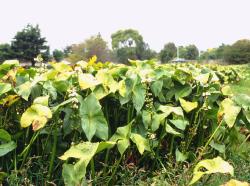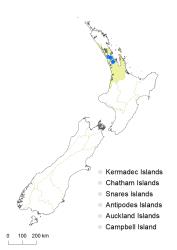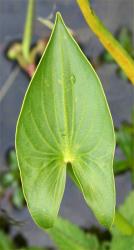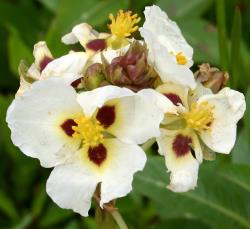- Taxon
- Weed
Erect, perennial herb, from a short, thick rhizome to 2 m tall, corms and stolons absent. Emergent leaves sheathing, petiolate; lamina 200–340 mm long, 195–260 mm wide, sagittate to hastate, glabrous, large lobes with caudate to acuminate tips, apex caudate or acuminate, margin entire; petioles 200–550 mm long, 5.0–20 mm wide, semi-terete (D-shaped), septate, glabrous. Inflorescence a whorled raceme or panicle, bracteate, 280–620 mm long, 50–150 mm wide; 3–15 whorls of 3–5 pedicellate flowers; scape 730–1800 mm long, 6–15 mm wide, erect, terete, emergent. Staminate flowers about 30 mm diameter, sterile carpels absent, pedicels spreading to ascending 0.2–1.3 mm wide, terete; sepals 7.0–12 mm long, 4–6 mm wide, ovate, concavo-convex, with conspicuous membranous margins; petals white with a dark red spot at base, 10–25 mm long, 20–25 mm wide, broad-ovate with a narrow claw, delicate, apex rounded, irregularly crenate; stamens 12–many; filaments 3–4 mm long, dilated, glabrous; carpellate flowers about 20 mm diameter, carpels many, staminodes absent, pedicels spreading, becoming recurved in fruit, distinctly thicker than staminate pedicels, terete; sepals 12–19 mm long, 7–10 mm wide, appressed and enclosing fruiting head, petals white with a dark red spot at base, delicate, deciduous 17–18 mm long, 18–20 mm wide, broad-ovate with a narrow claw, apex rounded. Fruiting head 12–20 mm diameter. Achenes 1.5–3.0 mm long, 1.5–2.0 mm wide, obovate with a lateral beak, winged, brown. Seeds uncinate, brown.
Sagittaria montevidensis has large, broad, arrow-shaped leaves and D-shaped petioles in T.S.; this and the white flowers with a conspicuous, dark-red petal spot distinguish it from other species of Sagittaria in New Zealand.
Sagittaria montevidensis subsp. calycina (not recorded in New Zealand) is distinguished by the absence of a coloured petal spot and shorter basal leaf-lobes (Haynes & Holm-Neilsen 1994).
Sagittaria montevidensis is a designated unwanted organism in New Zealand under the Biosecurity Act, is banned from sale and distribution, and is targeted for eradication wherever it occurs.
North Island: Auckland – Dairy Flat, Auckland City, Manukau, Wairoa River, Clevedon, Waikato (Ohinemuri River, Paeroa).
Shallow ponds, river margins, riparian edges and mudflats.
| Category | Number |
|---|---|
| Exotic: Fully Naturalised | 1 |
| Total | 1 |







